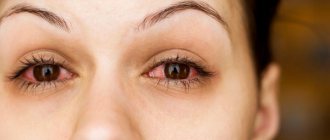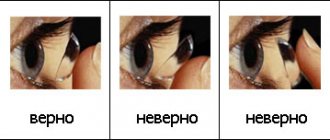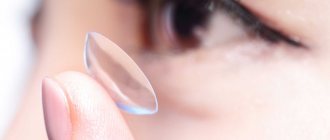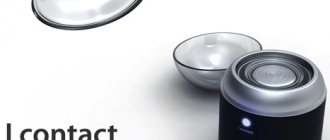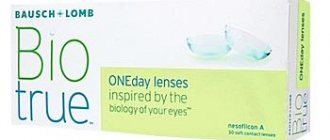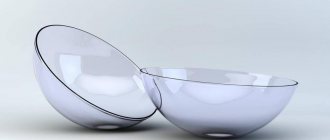What is conjunctivitis?
One of the most common eye pathologies is conjunctivitis. Both adults and children are susceptible to it. This disease is an inflammation of the conjunctiva - the mucous membrane of the eye that covers the sclera and the inner surface of the eyelids. Main
In this article
- What is conjunctivitis?
- What are the different forms of conjunctivitis?
- Contact lenses and features of wearing them
- When should you not wear contact lenses?
- Is it possible to wear contact lenses if you have conjunctivitis?
- Can conjunctivitis develop while wearing contact lenses?
- What are the risks of wearing lenses longer?
- What to do with lenses during conjunctivitis?
- When can I continue wearing lenses after recovery?
The causes of the disease are pathogenic microorganisms: bacteria, viruses and microbes. Often the disease is caused by allergic reactions. People with reduced immunity are especially susceptible to this. Characteristic symptoms of conjunctivitis are:
- redness of the eyelids;
- swelling of the mucous membranes of the eye;
- discharge of mucous or purulent secretion from the eyes;
- lacrimation;
- itching and burning.
In some cases, with conjunctivitis, the patient may experience a fear of bright light, a sensation of a foreign body in the eyes and blepharospasm - an involuntary contraction of the circular muscle of the eyeball. If the disease takes a severe course, and the rules for treating the pathology were not followed, then visual impairment due to damage to the cornea is possible. Conjunctivitis can pass from an acute to a chronic form, which often occurs together with ailments such as keratitis, blepharitis, etc.
Depending on the cause of infection, the symptoms of the disease vary. Based on them, as well as the results of the examination, the ophthalmologist determines the form of conjunctivitis that the patient suffers from. The prescribed treatment largely depends on this, since each form of the disease requires specific therapy. The following forms of the disease are distinguished:
- bacterial;
- viral;
- allergic.
This division is considered basic in ophthalmology. There are often cases of infection with a fungal form of conjunctivitis. It is often a concomitant pathology with candidiasis, actinomycosis and other diseases of fungal etiology. The cause of the inflammatory process may be chlamydia. This type of conjunctivitis is called chlamydial conjunctivitis. In adults, it often occurs against the background of trachoma, a chronic chlamydial infection that affects the conjunctiva and cornea of the eye.
Conjunctivitis is treated conservatively. Ophthalmologists prescribe local drug therapy to patients, which consists of using eye drops and ointments. In more rare and severe cases, subconjunctival injections may be used. Eye washes, for which you can use tea leaves and decoctions of medicinal herbs, such as chamomile or marshmallow root, are very helpful for conjunctivitis.
Symptoms
Symptoms of pink eye may vary depending on the type of conjunctivitis. If it is caused by a bacterial infection, then there are crusts on the eyelids and copious discharge from the eyes, which from time to time may acquire a greenish tint. The inflammatory process can spread to both eyes.
In the case of viral conjunctivitis, there will likely be swelling and hardening of the eyelids, and watery eyes with a small amount of discharge. In many cases, the process has a one-way course.
If the cause of conjunctivitis is an allergy, it is accompanied by itching, redness of the eyes and watery eyes. It is likely that along with this, nasal congestion and itching will be felt, and discharge will appear from the nasal passages.
What are the different forms of conjunctivitis?
Bacterial and viral forms of the disease differ from allergic ones by being highly contagious. This means that it is very easy to become infected with them from another person who already has conjunctivitis. The disease is quickly transmitted through household contact and airborne droplets. Infection can occur if hygiene rules are not followed: using other people's towels, handkerchiefs, decorative cosmetics, household items, etc. Sources of pathogenic microorganisms are saliva, tears, and nasal mucus.
In children's groups, the bacterial form of conjunctivitis is very common and often becomes the reason for quarantine. Infection mainly occurs due to violation of hygiene rules. The infection is transmitted through dirty toys, sand getting into the eyes, and during contact with animals. The inflammatory process itself is often called the “disease of unwashed hands.” The viral form of the pathology is usually associated with a viral infection that has entered the body. It can be of herpetic or adenoviral etiology. Viral conjunctivitis often “accompanies” the course of diseases such as:
- ARVI;
- acute respiratory infections;
- sinusitis;
- chicken pox;
- herpes;
- otitis;
- measles.
In adults, conjunctivitis can develop against the background of chronic blepharitis, dacryocystitis, and dry eye syndrome. The disease can occur due to irritation of the visual organs by tobacco smoke, household dust, and exposure to ultraviolet rays. Workers in the chemical industry are most susceptible to the disease. Conjunctivitis often occurs due to a lack of vitamins and a weak immune system of the body.
The allergic form is considered the most harmless of all existing ones. Largely due to the fact that this type of conjunctivitis cannot be contracted from another person. The disease occurs due to the body's hypersensitivity to an antigen. Allergic conjunctivitis can be caused by plant pollen, household chemicals, medications, animal hair, etc. Often the inflammatory process occurs against the background of spring hay fever, psoriasis, atopic eczema and other diseases of autoimmune etiology.
Symptoms
The symptoms of conjunctivitis are quite specific; it is quite easy to identify even without contacting an ophthalmologist. Among the signs of the disease are:
- severe redness of the white part of the eyes;
- swelling of the eyelids, puffiness;
- severe lacrimation;
- purulent or other type of discharge from the eyes;
- the formation of dried masses of pus on the eyelashes at night;
- photophobia;
- general deterioration of condition;
- itching, burning and other unpleasant sensations;
- blurred vision.
Purulent discharge from the eyes
On a note! If the eyes begin to fester severely, then most likely it is a bacterial form of conjunctivitis.
Very young children can also become too capricious, lethargic, and cry a lot. Older children begin to eat poorly, complain of blurred vision and a feeling of sand in the eyes.
But for an accurate diagnosis and determination of the nature of the disease, in any case you need to consult a doctor. Only he can prescribe the most effective treatment. The doctor interviews the patient or his parents, conducts a thorough eye examination, and tries to identify any additional symptoms or prerequisites for the development of the disease.
Is conjunctivitis contagious in children?
On a note! To identify the causative agent of conjunctivitis, an ophthalmologist may prescribe a smear examination of the mucous membrane or tests to identify allergens.
Conjunctivitis can be caused by various reasons and phenomena, which is why it has several forms. For example, if the disease developed suddenly, then most likely we are talking about acute conjunctivitis. If the character is chronic, then its symptoms do not develop as actively.
Main types of disease
Table. Types of conjunctivitis.
| Viral | In this case, the causative agent of the disease is an adenovirus, which can also cause the development of pharyngitis. This type of conjunctivitis can also be caused by the herpes virus or enterovirus. The disease is contagious and can spread very quickly within one social circle (for example, in a group in a kindergarten or family). It is transmitted through close contact between an infected person and a healthy person, as well as through toys, etc. |
| Bacterial | This type of conjunctivitis is often caused by streptococci, staphylococci or pneumococci, that is, pathogenic microorganisms. For the growth of their populations, a favorable environment is required, which is formed with insufficient personal hygiene. Also, weakened immunity can cause the development of this form of the disease. Sometimes the causative agents are gonococci or chlamydia, which enter the baby's eyeball when passing through the mother's birth canal. Older children usually contract bacterial conjunctivitis at home. |
| Allergic | The mucous membrane of the eyes of a number of people reacts sharply to certain substances that may be allergens. This could be plant pollen, secretions secreted by animal skin, etc. Upon contact with allergens, allergic conjunctivitis develops, which is often accompanied by rhinitis. |
We suggest you familiarize yourself with How to choose contact lenses for your eyes: remove them, which ones are better, choose them, correctly, eye drops when wearing them, remove them, reviews
Allergic conjunctivitis
Other forms of conjunctivitis can also be distinguished - follicular, catarrhal, membranous. As a rule, it is the catarrhal form that is easiest to cure, since the disease is mostly superficial.
With follicular conjunctivitis, a number of vesicles-follicles measuring up to 2 mm are formed on the mucous membrane. And with the membranous form, the eyeball is covered with a cloudy whitish or grayish film. It is easily removed, but ulcers may form in the places where it is attached to the mucous membrane.
Outcome of the membranous form of adenoviral conjunctivitis
With any type of disease, patients describe standard complaints: tears are constantly flowing, the eyes are red and look irritated, photophobia has appeared, the eyelids and conjunctiva are swollen. They are classified by type:
- Viral conjunctivitis appears as a concomitant manifestation of colds. Its precursors are considered to be a sore throat, catarrhal rhinitis and fever. First, irritation begins in one eye and spreads to the other. Accompanied by lacrimation, lack of pus in the secretion and intermittent itching;
- Bacterial conjunctivitis. First, a cloudy, viscous, yellowish, grayish liquid begins to come out of the eyes, and often the eyelids stick together after sleep. But not all bacteria cause such discharge; the second manifestations include dry conjunctiva and skin near the sore eye. One eye gets sick, but after it the infection spreads to the second. The eyes begin to hurt, you want to pull out the foreign body;
- Allergic conjunctivitis begins with unbearable itching, pain, slight swelling of the eyelids and conjunctiva. If symptoms appear along with allergic rhinitis or bronchial asthma, the appropriate signs will be added;
- Conjunctivitis, which is caused by toxic and irritating compounds - the most common symptom is soreness, nothing else;
- Acute conjunctivitis develops rapidly: purulent substance flows from the eyes, tears roll down. Photophobia and pain in the eyes appear, sometimes accompanied by ulcers and infiltrates on the cornea;
- Chronic conjunctivitis is manifested by itching and burning, patients feel as if their eyes are covered with sand.
Contact lenses and features of wearing them
contact lenses. These ophthalmic products can be called the optimal solution for people with poor vision. Lenses can be used for visual impairments such as:
- myopia;
- farsightedness;
- astigmatism,
- presbyopia.
glasses that have been worn for many years to modern models of contact lenses. Today they are produced by companies in many countries, including Russia. A significant advantage of contact correction means is the ability to provide both central and peripheral vision. Glasses, unfortunately, cannot cope with this task. Lenses provide more natural vision correction than glasses. This is due to the fact that the contact optics moves simultaneously with the movement of the pupil. Thanks to this, it is possible to avoid distortions, inaccurate transmission of dimensions and a decrease in the field of view. Many people encounter such problems when using glasses.
You can wear lenses in any weather conditions. When it rains or snows, the glasses fog up, affecting visibility, while contact lenses continue to provide clear vision. Unlike glasses, lenses can be worn while playing sports. They do not prevent a person from leading an active lifestyle. You can wear them for morning jogging and professional sports. This is one of the reasons why contact lenses are very popular today among people who need vision correction. Many people do not think about whether it is possible to wear lenses during illness. The use of optical products is commonplace for them, so it is difficult for them to imagine even one day without lenses. Many people have been correcting their vision using contact optics for many years. Typically, they continue to use lenses during treatment of the disease, including conjunctivitis.
Actions of the doctor to alleviate the patient's condition
An ophthalmologist will be able to make an accurate diagnosis. Sometimes you will additionally need to do a smear or scraping to determine which microorganisms led to the inflammation. Only a specialist provides therapy.
When eliminating allergic conjunctivitis, success depends on the correct identification of the allergen in order to urgently stop the patient’s contact with the irritating factor. After eliminating the allergen, artificial tear preparations are used to eliminate irritation in the eyes.
Cold compresses on the eye area relieve the condition. When it is impossible to eliminate the allergen, the doctor prescribes antihistamines. Antiallergic drugs are prescribed internally (suprastin, claritin), and hormones (prednisolone, hydrocortisone) are prescribed for topical use.
Antibiotics in the form of drops (0.25% levomycetin solution) help relieve the symptoms of bacterial conjunctivitis. When a lot of fluid flows out of the eye, it is washed with solutions of potassium permanganate or furatsilin, in addition, 1% oletethrin ointment is applied (for mild cases of the disease, once a day is enough, for severe cases - 2-3 times).
Sometimes giant papillary conjunctivitis occurs. Even patients who prefer soft lenses experience alarming phenomena: mucus is released from the eyes, they itch, the conjunctiva turns red, and a foreign body is felt.
Medium-sized papillae grow on the conjunctiva of the upper eyelid. Point erosions and opacities form on the cornea. Sometimes, while using lenses, giant papillary conjunctivitis begins to develop.
The onset of the disease begins from mechanical damage to the conjunctiva. Such reasons include: ocular prostheses, contact lenses, prolonged irritability from stitches after surgical operations.
The mechanism of development of giant papillary conjunctivitis is unknown. It does not appear instantly, but when time has passed after using prostheses or wearing CL. Delayed allergic manifestations are called delayed-type hypersensitive reactions.
When wearing CL, a person feels good, nothing irritates him. Over time, problems begin: the eyes itch and turn red, tears flow, mucus begins to secrete, and vision becomes much worse.
An unpleasant sensation is caused by large follicles that grow on the conjunctiva of the upper eyelid. This occurs due to the proliferation of collagen tissue under the epithelial layer of the conjunctiva.
If the impetus for giant papillary conjunctivitis was sutures that were not removed after surgery, then the inconvenience can be easily eliminated: urgently remove the sutures. When conjunctivitis appears from wearing lenses, they are abandoned for a while, and glasses are used until recovery. Treatment is prescribed using antiallergic and anti-inflammatory drops.
Instead of old lenses, you will have to purchase new ones, but only after all the symptoms of the disease disappear. To select lenses, you should go to a qualified specialist; he will solve the problem individually.
Treatment of conjunctivitis is not as difficult as it seems. But the greatest effectiveness from the methods used can be obtained if you know exactly the type of disease. As a rule, drops, ointments, and various eye wash compositions are used for therapeutic purposes.
Systemic medications can also be prescribed that will have a complete effect on the body. Bacterial conjunctivitis is treated with antibiotics that have a targeted or general effect.
Treatment of conjunctivitis in a child
Attention! Antibiotics are drugs that have a strong effect on the human body. Under no circumstances should a child be prescribed them independently. Only a doctor can write a prescription for this type of medication.
For children under 1 year of age, the doctor may prescribe drops such as Vitabact, Levomycetin, Albucid. For an uncomplicated viral form of the disease, interferon-based drops are sometimes used to help maintain and enhance local immunity. If conjunctivitis is caused by allergies, then antihistamines are prescribed.
Vitabact
Before instilling or using ointments, it is imperative to clean the eyes, the skin around them and the mucous membranes from pus. You need to put drops in your child's eyes from bottles with soft spouts to avoid injury.
For viral or bacterial conjunctivitis, the ophthalmologist usually prescribes eye rinsing in addition to the use of medications. Washing is carried out every 2-3 hours. To do this, you can use chamomile decoction or Furacilin solution.
The latter is prepared at the rate of 1 tablet per 0.5 glass of water at room temperature. When the symptoms of the disease begin to lose their intensity, you can wash your eyes less often - three times a day will be enough.
Chamomile decoction
Sometimes it is enough to use boiled water to wash your eyes. The main thing is that it is clean and not hot.
Washing a child's eyes
When washing, sterile gauze wipes are used, and it is important to use a clean one for each eye, especially if only one eye is affected by conjunctivitis. You need to move the gauze napkin soaked in the solution in the direction from the temple to the nose. The solution prepared for washing the eyes can also be used to wash the face.
Solutions for these procedures should only be prepared using boiled water, which should cool to room temperature. All items used to manipulate the eyes (pipettes, swabs, etc.
Both eyes need to be rinsed
Among the folk remedies used for washing the eyes, in addition to the chamomile solution, one can note oak bark, calendula or aloe. These products have a pronounced antibacterial effect, relieve swelling, relieve burning and redness of the eyes.
A solution based on aloe vera is prepared as follows: 5 leaves are washed with clean water and poured with 0.5 liters of boiling water, then infused for several hours. This solution is used at least 3 times during the day.
To reduce the risk of developing conjunctivitis, a number of preventive measures are required. It is important to monitor the child’s immunity and give him vitamins during periods of vitamin deficiency. Nutrition should be balanced and of high quality.
The main preventive measure is personal hygiene, as well as a healthy lifestyle with frequent walks. It is important to wash your hands as often as possible throughout the day using soap. In a house where a very small child lives, wet cleaning is required frequently.
We suggest that you familiarize yourself with astigmatism colored lenses - Eye Diseases
The child should wash his hands as often as possible
The main signs of this type of conjunctivitis:
- redness of the eyes;
- feeling of discomfort, interference in the eye;
- hypertrophy (increase in size) of the papillae of the conjunctiva of the upper eyelid.
Red eyes, brightly colored visible blood vessels, are a general, nonspecific reaction associated with inflammation. A feeling of obstruction in the eye, itching and burning will also be common symptoms for many eye diseases.
The mucous discharge is usually in small quantities. The adjacent lymph nodes are not enlarged. This makes it possible to distinguish this form of the disease from viral and bacterial conjunctivitis. It differs from other diseases with similar manifestations in the absence of a pronounced decrease in vision.
A specific symptom for giant papillary conjunctivitis is the appearance of hypertrophy of the papillae of the conjunctiva of the upper eyelid. They can be detected when examining the patient.
To confirm the diagnosis, a slit lamp examination is performed.
The listed signs of the disease appear a considerable time after the start of using contact lenses; the period of visible well-being can last for several months, which distinguishes this type of conjunctivitis from allergic conjunctivitis, whose symptoms are felt immediately.
How to cure the disease
After identifying the disease and making a diagnosis, the specialist recommends limiting the use of contact lenses. This can be done in two ways: abandon them completely for a while or switch to using the one-day option.
Important! Compliance with hygiene rules should be strengthened, cleaning and treatment should be carried out more often and more carefully, and moisturizing drops should be used.
If the patient uses glasses for some time, the eyes will have the opportunity to rest, and the full supply of oxygen to the cornea will be restored. A month after completing the course of treatment, you can use other contact lenses again.
The appearance of papillae is associated with disruption of the so-called mast cells, which are in a mature state in the connective tissue, including the conjunctiva. Therefore, for treatment it is recommended to take drugs that regulate the functioning of these cells.
Photo 1. Lecrolin eye drops 10 ml, in solution 20 mg/ml. .
In severe cases, short-term local use of steroid drugs, for example, eye drops containing dexamethasone, is acceptable, but this course of treatment should only be carried out under the supervision of a physician.
To reduce burning and itching, the use of artificial tears, such as Vidisik gel, is prescribed. Cold compresses can be used to relieve the condition.
When should you not wear contact lenses?
There are certain reasons why wearing lenses is not allowed. Such contraindications can be either temporary or permanent. The permanent ones include quite serious diseases. These include:
- glaucoma;
- corneal clouding;
- dislocation of the eye lens;
- high degree strabismus;
- tuberculosis;
- AIDS.
If a person has one of these ailments, they should absolutely not wear lenses. The list of temporary contraindications is wider than the list of permanent ones. These optical products are not recommended for use in the following cases:
- for viral diseases;
- during rehabilitation after laser vision correction;
- when taking oral contraceptives;
- during allergies.
One of the particularly serious circumstances that prohibit wearing contact lenses is infectious and inflammatory diseases of the visual organs, in particular conjunctivitis. They cannot be used not only during the peak of the disease, but also when its symptoms are detected. At the first signs of pathology, you need to visit an ophthalmologist and choose glasses that can replace lenses during the disease.
Is it possible to wear contact lenses if you have conjunctivitis?
Usually in the first days of illness a person does not experience discomfort due to the use of contact lenses. But after some time, he begins to be bothered by itching, burning, redness of the eyes, and watery eyes. As soon as these symptoms occur, optical products immediately become carriers of pathogenic microorganisms: bacteria, microbes, viruses. For this reason, eye doctors do not recommend continuing to use lenses during illness. This prohibition by doctors is due to the fact that conjunctivitis when wearing contact lenses is more difficult to cure. During illness, their use often causes a lack of tear fluid, which helps moisturize the cornea. In the viral form, especially when accompanying colds, lenses quickly become sources of viruses. This can happen when you cough or sneeze. The treatment loses its effectiveness, the inflammatory process continues to progress.
Contact lenses are a foreign body to the eyes. Very often their use becomes an obstacle in the treatment of conjunctivitis. This is especially true for traditional models, as well as prolonged wear, which can be used for several days in a row without taking them off. Having a foreign body in the eyes for several days and sometimes weeks does not contribute to treatment in any way, but only worsens the patient’s condition. Lenses intended for one to three months of use should also not be worn while sick. Optical products themselves become sources of infection and interfere with the treatment prescribed by the ophthalmologist. Their use can cause various complications and significantly increase the duration of the disease. In especially severe cases, the disease can become chronic.
Wearing lenses for conjunctivitis is not recommended for another reason. These optical products fit tightly to the cornea and impede the movement of the eyelids, which contribute to the release of mucous or purulent contents. In bacterial and viral forms of the disease, this is especially important, since in the absence of the possibility of exit, the discharge becomes the cause of the development of microbial flora.
The right solution is to be examined by an eye doctor.
If conjunctivitis is not associated with colds and occurs constantly, then it is better to go to the doctor. He will conduct a comprehensive examination of the eyes, assess the condition of the mucous membrane, and check whether the internal structures of the eyes and visual acuity are affected by this disease. Such an examination will help to avoid complications and recurrence of symptoms, and to choose the right treatment.
Can conjunctivitis develop while wearing contact lenses?
Some people believe that constantly wearing contact lenses can cause conjunctivitis. We cannot agree with this statement, nor can we refute it. In fact, the optical products themselves are absolutely safe, and their use cannot lead to ophthalmological diseases. But under one condition - the lenses are processed as stated in the instructions.
Proper care of contact optics plays an important role and guarantees safety for the visual organs. It is very important to promptly change the containers used to store lenses, as well as replace tweezers, suction sticks or other accessories that are used when wearing ophthalmic products. Optical products can only be cleaned and disinfected with fresh solution. It is prohibited to use liquid that was previously filled in the container for this purpose.
You should not use contact lenses during viral diseases. Even with a common runny nose or cough, it is better to stop wearing them. During ARVI, sore throat, influenza and other diseases that are often accompanied by conjunctivitis, the use of lenses can lead to clouding of the cornea. This will negatively affect the condition of the visual organs and prevent the disease from being cured in a short time. The limitation especially applies to models of prolonged wear, since they are on the eyes for a long time. The only form of the disease when conjunctivitis occurs from lenses is papillary. This is a non-infectious inflammation of the mucous membrane of the eye, which is accompanied by proliferation of the papillae. Other names for this pathology: “papillary conjunctivitis”, “giant papillary conjunctivitis”. This form of the disease is associated with the fact that a person wears long-lasting contact lenses, traditional optical products, or does not follow the regime for replacing them.
The clinical manifestations of papillary conjunctivitis are quite obvious and diagnosis is not a problem. It can be easily identified by such a symptom as the proliferation of papillae. They are called papillae and are located on the conjunctiva. During the inflammatory process, they acquire larger sizes, cause discomfort, and are accompanied by such classic signs of conjunctivitis as:
- itching and burning;
- mucous discharge from the eyes;
- redness and swelling of the mucous membrane;
- sensation of a foreign body in the eyes;
- impaired vision clarity.
The first step in treating papillary conjunctivitis while wearing contact lenses is to stop using them. In some cases, they can be replaced with daily optical products, but only after consultation with an ophthalmologist. If you continue to wear contact lenses with papillary conjunctivitis, there is a risk of the inflammatory process becoming chronic.
Symptoms of allergic conjunctivitis
People with all forms of allergic conjunctivitis experience severe itching and burning in both eyes. Although symptoms usually occur in both eyes, in some cases one eye may be more affected than the other. The conjunctiva becomes red and sometimes swells, giving the eyeball a swollen appearance.
With seasonal and year-round conjunctivitis, a large amount of liquid, watery discharge appears, which can sometimes become viscous. Occasionally, vision may deteriorate. Most people suffering from this disease also note the presence of a runny nose.
With spring conjunctivitis, the discharge from the eyes is thick and mucus-like. It, unlike other types of allergic conjunctivitis, often causes damage to the cornea and leads to painful ulcers. The latter cause severe pain in the eye when looking at bright light and sometimes lead to permanent loss of vision.
What are the risks of wearing lenses longer?
Another rule that must be followed when using lenses is to strictly adhere to the wearing period. It is indicated on the packaging by the manufacturer. If ophthalmic products are intended for a month, then they can be worn for no more than 30 days. This period is counted from the moment the blister is opened - the original packaging in which the contact lenses were stored before use. Therefore, even if a person has not worn them for several days, this does not extend the period of wearing them.
Various complications are associated with wearing lenses too long. First of all, the problems are associated with corneal hypoxia - an insufficient amount of oxygen reaching it. This disrupts the metabolism of the cells of the cornea. When wearing contact lenses longer than the period indicated on the package, the body tries to independently replenish the supply of cells. Vessels located outside the cornea are actively involved in this process. This leads to the fact that they grow through the stroma, causing eye hyperemia.
Wearing lenses too long increases the risk of developing an eye infection. This mainly occurs due to violation of hygiene rules. For example, you should not touch contact optics with dirty hands. If a person wants to remove lenses from his eyes, he must wash his hands and only then perform any actions with optical products. Failure to comply with this rule may cause the development of conjunctivitis.
What to do with lenses during conjunctivitis?
If you have conjunctivitis, wearing contact lenses is strictly prohibited. Features of the treatment of this disease require unhindered access of oxygen to the cornea and strict adherence to hygiene rules. During illness, it is recommended to replace the lenses with glasses, which are the optimal solution for many ophthalmological diseases. Treatment of bacterial, viral and allergic conjunctivitis is not allowed when using lenses.
Ophthalmologists do not recommend wearing contact lenses if you have conjunctivitis due to the fact that their material provides an excellent environment for the proliferation of pathogenic microorganisms. This applies to hydrogel and silicone hydrogel models. Discomfort when using ophthalmic products is often associated with the fact that when removing or putting them on, a person can accidentally damage the cornea, and this aggravates the course of the disease.
Treatment for conjunctivitis includes the use of eye drops, such as:
- "Albucid";
- "Florenal";
- "Tobrex";
- "Levomycetin".
They cannot be used when wearing contact lenses. Contact of the drug with the material from which they are made can lead to deterioration of optical characteristics. This is another reason why wearing lenses during illness is not recommended. It's better to replace them with glasses. If the ophthalmologist has diagnosed “conjunctivitis,” then the lenses should be removed immediately, since during the incubation period they have already “adopted” some of the pathogenic microorganisms. Such optical products pose a danger to the visual organs and may interfere with treatment prescribed by the ophthalmologist. It is impossible to disinfect lenses with conjunctivitis using a disinfectant solution. This product is intended for cleaning optical products from dust particles and decorative cosmetics that accumulate on their surface during use, as well as for disinfecting them. It cannot be used to combat pathogenic microorganisms that cause conjunctivitis.
Actions of the doctor to alleviate the patient's condition
In case of unpleasant manifestations of diseases in the eyes, lenses instantly turn into a source of bacteria and viruses. The patient feels much worse, because CLs serve as an additional irritant to the visual organs.
Sometimes contact lenses provoke illness, although they are completely harmless to the eyes. They only cause harm if hygiene is neglected.
When wearing contact lenses during treatment, the cornea may become cloudy, which will negatively affect vision. Conjunctivitis is a contagious disease; learn to follow the rules of hygiene so as not to become a source of infection.
An additional reason for not wearing contact lenses during treatment is that you should absolutely not touch your vision. There is only one exception: when you need to instill drops prescribed by your doctor.
In the eye, the lens acts as a foreign body. It acts as a barrier to prevent the drug from quickly penetrating into the affected eye. The disease can drag on for a long time, in addition, complications will appear.
To prevent relapses, you must adhere to hygiene rules and all recommendations for lens care. Frequent hand washing with soap and using individual towels will save you from trouble. Lenses that become unusable should be thrown away immediately.
Mechanical irritation most often occurs when the lens is damaged: if its edge is stretched, it injures the mucous membrane.
In some cases, contact lens care liquids become a source of discomfort. This is usually due to the body’s reaction to the components of the solution. The latter includes several components:
- cleaning surfactants;
- salts that maintain the osmotic pressure of the liquid and correspond in composition to tears;
- humectants;
- substances that prevent the growth and development of bacteria.
The latter often become the culprits of the painful reaction of the eyes to such solutions.
The safest use of disinfectants made on the basis of hydrogen peroxide.
Due to their effectiveness, they can be used in concentrations below the level of eye sensitivity, which virtually eliminates a negative reaction to them.
When using long-term wear lenses, due to insufficiently precise selection of liquid for their care, an accumulation of protein residue contained in tears often forms on their surface. It causes a reaction in the body similar to an allergic one.
When can I continue wearing lenses after recovery?
During the day, various deposits accumulate on the surface of ophthalmic products, which are very dangerous for the eyes during the first time after recovery. They can provoke a relapse of the disease and the need for re-treatment. This is also fraught with the fact that conjunctivitis, with frequent manifestations, can take on a chronic form.
A few days after recovery, you can also wear planned replacement models, which are designed for two weeks, a month or 90 days of use. An ophthalmologist will recommend which optical products are best to use. It is very important to follow the rules of care and treat contact lenses with a disinfectant solution. After treatment for conjunctivitis is completed, it is better to choose one that does not contain preservatives in its composition. This will help you recover faster from illness.
How many days after conjunctivitis can a CL be worn?
When a person has recovered from conjunctivitis, he should purchase new contact lenses. This need is due to the following: various harmful deposits remain on the CL, which can provoke a relapse of the disease.
We invite you to familiarize yourself with Conjunctivitis: causes, symptoms and treatment of conjunctivitis
A regular solution will not help get rid of microorganisms that have settled on the lenses, so the old pair must be disposed of. Many people are interested in when they can put on a CL after conjunctivitis has passed. 5 days after eliminating the inflammatory process, you can begin to use new optical glasses.
It is strongly recommended to give preference to one-day soft CLs, which will minimize the risk of relapse of the eye disease and secondary infection. Such lenses provide increased safety, and all due to the absence of the need for additional moistening or cleaning of the optical medium.
For the manufacture of some models of one-day SCLs, a special material is used - hypergel, which ensures the flow of oxygen to the organ of vision.
If you purchase standard contact lenses, which have a minimum service life of 3 months, you need to adhere to hygiene rules so as not to become infected again.

